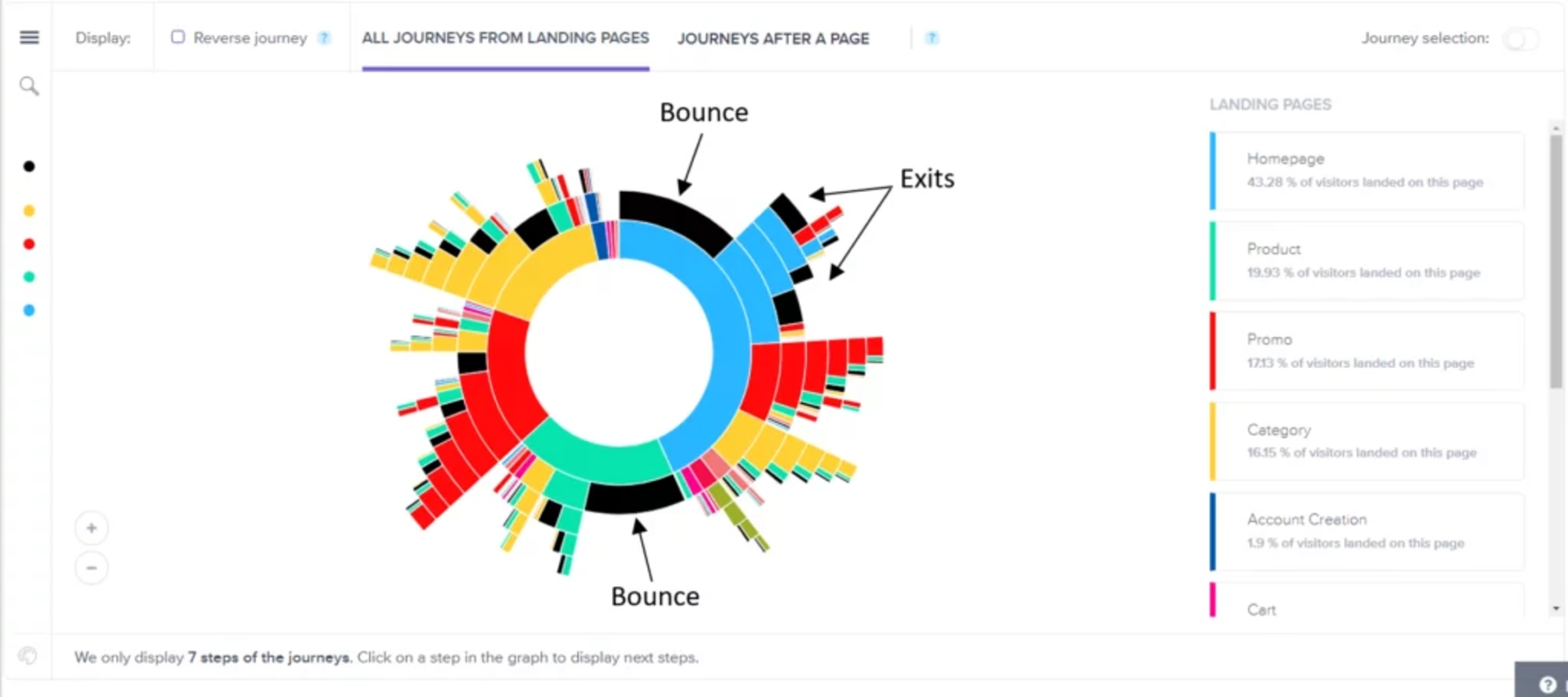UX analytics can help you see how your website is being accessed and used. But did you know you can take this to the next level by extracting behavioral data on your site visitors, such that displays the consumer decision journey? This kind of insight reveals why and how users are interacting with your website.
Customer journey maps help you amass a comprehensive snapshot of all the pages your customers visit on your website during each stay.
Along with customer journey mapping, there is a slew of other UX analytics data that showcases a more granular view of visitors’ site meanderings. This type of data has a twofold capacity: understanding your customers’ mindset as they navigate your site, and digging into what drives (or stalls) the consumer decision journey.
Customer Journey Analysis: Your Customers’ Page by Page Motions
Customer journey analysis aggregates user interactions on your site to help you understand the many paths visitors take through your platform. Mapping out the steps visitors take on your website can help you understand user intent and locate stumbling blocks along the customer decision journey.
You may, for example, notice a spike in one of your site pages. Viewing the traffic on these pages alone won’t reveal much about why or how your users have landed there. That’s where customer journey analysis is useful: it shows all the pages your consumers have gone through before reaching a particular page, or, as most business owners would prefer, before they covert. It’s also useful for revealing where visitors get lost, abandon their journey or bounce.
Accessing this start-to-finish view of journeys allows you to drill down into the navigation patterns of your most valuable behavioral segments for a more granular understanding of what is preventing them from reaching their goal(s).
You may notice some visitors go back and forth multiple times between the category and product page before exiting your site — are they happily window-shopping or are they stuck in a loop, unable to find what they are looking for?
The answer is in the consumer’s decision journey — visitors are communicating their frustrations and delight with the user experience through each of their interactions. Being able to measure engagement (but also revenue metrics) on each in-page element of your site is the next step to removing the roadblocks to conversion.

Read our article on User Replay here.
Behavioral Insights From Granular Data: Your Visitors’ In-Page Experience
While customer journey analysis provides an overview, a first look with a high-level vantage point at how visitors peruse your site pages, it’s important to follow it up with an in-depth, in-page analysis. The following section highlights just a few of the metrics that can add a layer of insight to your understanding of your consumer decision journeys and help you derive a deep-read of your customers’ UX on your website. These bits of behavioral analytics will help drive your understanding of your customer’s decision journey into much further detail.
Engagement Rate
If your content is engaging, there’s a good chance it’s having a positive impact on your consumers’ decision journey. So how do you go about measuring a concept as subjective as engagement? We dot it by combining two other behavior KPIs.
Since clicks are often representative of interest, at least some degree of it, we base the engagement levels off of them. While hovers may also indicate interest among users, they can also point to confusion and even hesitation among site users.
That’s why to measure the engagement rate, we calculate how many visitors clicked on a zone after hovering over it. Specifically, this is reflected as a percentage of visitors who clicked after hovering. Before your customers convert, or if they choose to leave without converting, this KPI divulges which elements are intuitive and which aren’t, which essentially shows you how such elements contribute to your customers’ decision journey.
Click Rate
Piggybacking off of the importance of clicks, click rate delves even further into analyzing how clicks contribute to consumer decision-making. The click rate observes how many clicks occurred in relation to page views, since viewing a page alone does not guarantee engagement.
The click rate is a calculation of the number of page views where a zone was clicked divided by the total number of page views. This metric allows you to determine how many site visitors clicked at least once on a zone (or in-page element) for each page view.
This is relevant to understanding customers’ decision journey since not all page views will lead to clicks and not all zones will receive clicks either.
Understanding how many times visitors clicked at least once on a zone during a page view helps you understand which zones are most engaging to customers. This conveys how these zones and their usage contribute to navigation and bring visitors closer to meeting their goals.

Hesitation Time
Understanding where users hesitate on your website can convey either interest or confusion and is measured as the time elapsed between the last hover and the first click on a zone. While some site elements allow you to infer your visitors’ sentiments when they hesitate, others might require some more digging.
Perhaps the copy isn’t clear, maybe an element’s clickability is murky. In either case, you should survey hesitation time in order to understand if your content is easily understood.
This metric is ideal for interpreting whether images are being consumed properly. For example, if a text-heavy visual has a high hesitation rate, it could simply be a sign that the content is being consumed as intended. On the other hand, a visual with little copy and a high hesitation rate could convey confusion and present an argument for optimizing the UX of this area.
Conversion Rate Per Click
Clicks are demonstrative of some level of interest, but wouldn’t it be great to know if clicking on a zone impacts your behavior and conversion goals? Well, there’s a certain UX metric that can measure just that: conversion rate per click. This metric is determined by the number of users who clicked on a zone and completed the behavior, divided by the number of users who clicked on the zone.
This is especially useful when analyzing a category page, in that it shows which zones are helping customers achieve the goal of reaching a product page. After all, they need to be on a product page to view your products and most importantly, buy them. When users are on a product page, this metric helps you analyze which zones are helping customers accomplish the goal of adding to their cart.
In these respects, this metric gauges the performance of zones according to your business objectives. It helps you see the strengths and weakness of your content and pinpoints the role of the zones on a page in propelling your visitors’ decisions.
Understanding Your Customers’ Decision Journey
When analyzing visitor journeys on your site, it can be tricky to understand why your site users behave the way they do. Digital behavior insights can help you visualize the frustrations and impediments along the decision journey, helping you see which elements of your platforms are intuitive or obtuse, clickable or not, conducive conversions or off-putting.
Key to improving the experience for customers is first and foremost understanding what it is they are trying to achieve on your site. With a bird’s eye view of their navigation and an elemental analysis of each touchpoint, you can optimize the decision process and maximize conversions.
![[Visual] Lorraine Ryshin](http://images.ctfassets.net/gwbpo1m641r7/2XNOEXXergRbFit5YrkUJ2/fbda872dab7930f0181bfe5718109d2f/T027K0ZC9-UEPDCM3PT-4cdb12d10e25-512.jpeg?w=1080&q=100&fit=fill&fm=avif)
Lorraine was a Content Writer at Contentsquare, with a knack for crafting words for the internet. A multidisciplinary writer with a background in marketing and SEO, she produced content for clients across a wide range of industries and disciplines. To hone her professional pursuits, she sought out new and creative channels to communicate with digital audiences.
